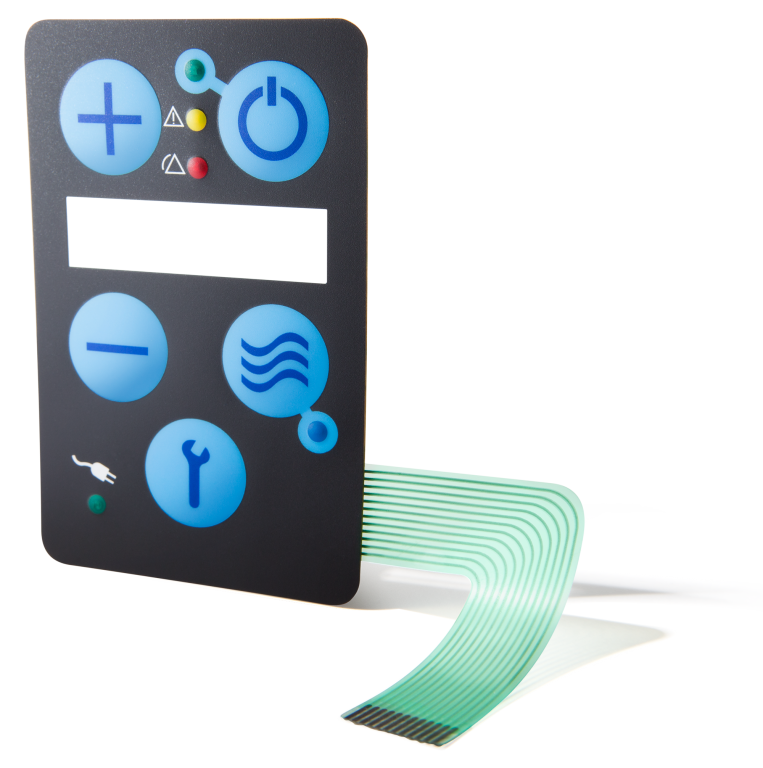Understanding Membrane Layer Switches Over: The Trick to Durable and Reliable Controls

What Are Membrane Switches?
Membrane layer switches are an innovative remedy in the world of customer interface innovation, incorporating capability and style effortlessly. These gadgets offer as an interface between users and digital systems, incorporating numerous parts into a portable style. Typically built from flexible, slim layers of materials, membrane buttons are designed to respond to touch, allowing customers to interact with equipment and digital devices efficiently.
The main components of a membrane layer button include a printed circuit layer, graphic overlay, and a spacer layer that stops unexpected activation. The visuals overlay can be personalized to show brand identity or user choices, improving aesthetics while making sure use. Membrane switches are typically utilized in various applications, consisting of medical devices, consumer electronics, and industrial tools, owing to their resilience and resistance to ecological aspects such as moisture and dust.
Among the essential benefits of membrane layer switches is their capacity to hold up against deterioration, making them ideal for high-traffic atmospheres. Additionally, they are light-weight and require minimal room, permitting for ingenious styles in item advancement. Overall, membrane layer switches represent a practical and efficient option for modern electronic user interfaces, weding technology with user-centric design concepts.
Exactly How Membrane Switches Work
The operation of membrane layer switches hinges on a basic yet reliable device that converts individual input into electronic signals. When a customer presses the button, the leading layer flaws, enabling a conductive aspect in the circuit layer to make contact with an equivalent conductive pad on the bottom of the graphic overlay.
The design of membrane switches can vary, but they commonly include domes or responsive components to supply comments to the customer, improving the general experience - membrane switch. The materials made use of in membrane buttons, such as polyester or polycarbonate, contribute to their longevity and resistance to ecological factors, including wetness and dirt. Furthermore, the published circuits are normally encapsulated, which secures them from deterioration over time.
Advantages of Membrane Buttons

In addition, membrane buttons are understood for their toughness. Built from robust materials, they are immune to dirt, dampness, and physical wear, which substantially expands their lifespan contrasted to standard mechanical switches. This longevity makes them especially appropriate for high-traffic atmospheres and applications calling for longevity.
An additional substantial benefit is the simplicity of cleansing and maintenance. The smooth surface of membrane layer switches over reduces dirt buildup and is typically resistant to spills, making them optimal for settings that call for constant sanitization.
Moreover, membrane layer switches offer a streamlined account, causing a thinner layout that can be incorporated into different gadgets without adding bulk. This attribute not only improves the visual appeal yet likewise adds to a more ergonomic item design.
Applications of Membrane Layer Buttons
Versatile and user-friendly, membrane layer buttons discover applications across a vast array of sectors, including medical gadgets, consumer electronics, and industrial devices. In the medical area, these switches are essential to gadgets such as analysis equipment, important source client monitoring systems, and mixture pumps, where reliability and simplicity of cleaning are vital. Their ability to preserve and withstand extreme settings capability makes them suitable for such applications.

In consumer electronics, membrane buttons are made use of in items like microwaves, cleaning machines, and push-button controls - membrane switch. Their sleek layout enables instinctive interface, boosting the general individual experience while supplying toughness and resistance to deterioration
Commercial tools likewise gains from membrane you can find out more layer buttons, especially in control panels for equipment and automation systems. These buttons supply protection versus dirt and wetness, ensuring regular efficiency in difficult atmospheres. Their customizable attributes allow suppliers to tailor them to specific operational requirements, improving performance and he has a good point capability.
Picking the Right Membrane Switch Over
When selecting a membrane layer button, it is necessary to consider different aspects that influence performance and viability for particular applications. The key factors to consider consist of environmental conditions, tactile comments, longevity, and design specifications.
First, assess the operating environment; switches exposed to dampness, chemicals, or extreme temperature levels call for certain products to make certain long life and performance. Next, examine the need for responsive feedback. Depending upon customer communication, some applications might gain from a responsive reaction to verify activation, while others might like a non-tactile design for aesthetic factors.
Longevity is an additional important element; membrane layer switches need to be made to endure constant use, impacts, and abrasion. Guarantee the chosen button can endure the anticipated lifecycle, particularly in high-usage circumstances.

Conclusion
To conclude, membrane switches act as crucial elements in the design of durable and reputable control systems across various markets. Their small design, combined with durable building and personalized functions, boosts customer interaction while guaranteeing long life popular settings. The flexibility of membrane switches permits customized options that fulfill details operational requirements, reinforcing their relevance in modern-day technology. As markets proceed to advance, the relevance of integrating efficient membrane layer switch remedies can not be overstated.
Membrane layer switches over stand for a crucial facet of modern-day user interface style, blending functionality with durability in numerous applications.Membrane switches are an innovative service in the world of customer interface innovation, incorporating capability and style seamlessly. Generally created from flexible, thin layers of products, membrane switches are developed to react to touch, enabling individuals to interact with equipment and digital devices properly.
The design of membrane layer buttons can differ, yet they often incorporate domes or tactile elements to offer responses to the individual, enhancing the total experience.In verdict, membrane layer switches serve as crucial components in the design of dependable and durable control systems across different markets.